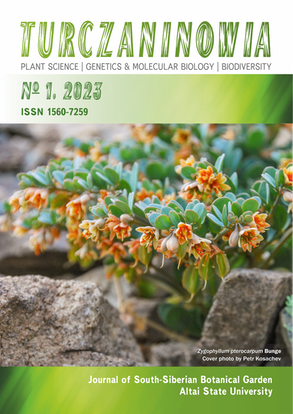On the genetic structure of Eversmannia subspinosa populations in Russia
UDC 582.736+575.857(470+571)
Abstract
We have studied the genetic structure of Eversmannia subspinosa (Fisch. ex DC.) B. Fedtsch. populations from the Russian Federation (the Bolshoe Bogdo Mt., the Astrakhan Region; Kegul’ta gully, Republic of Kalmykia) and a number of specimens from the Middle Asia (Kazakhztan and Kyrgyzstan) using inter-simple sequence repeats (ISSR) markers, sequenced nuclear (ITS 1, 2) and chloroplast markers (trnL-trnF, atpB-rbcL, rpl32-trnL(UAG), trnV-ndhC). The analysis of ISSR markers divided samples into three genetic clusters: the population from the Bolshoe Bogdo Mt., the population from the Kegul’ta gully, and samples from the Middle Asia. The population from the Kegul’ta gully appeared to be genetically variable, whereas the population from the Bolshoe Bogdo Mt. exhibited no variation. Populations from the Bolshoe Bogdo and Kegul’ta are more closely related according to the results of the chloroplast DNA analysis. At the same time, these westernmost populations turned out to be related to the samples from the Western Tian Shan: Syr-Darya Karatau, Talas Alatau (Ichkele-Too Mts.) and Kyzylorda Region of Kazakhstan.
Downloads
Metrics
References
Вuntjеr J. В. 2000. Cross Checker: computer assisted sсоring of genetic AFLP data. In: Plant & Animal Gеnоmе: VIlI Conference (San Diego, СА, January 9–12). URL: http://wheat.pw.usda.gov/jag/papers99/paper599/indexp599.html
Clement M., Posada D., Crandall K. A. 2000. TCS: A computer program to estimate gene genealogies. Mol. Ecol. 9: 1657–1659.
Edler D., Klein J., Antonelli A., Silvestro D. 2021. raxmlGUI 2.0: A graphical interface and toolkit for phylogenetic analyses using RAxML. Meth. Ecol. Evol. 12: 373–377. DOI: 10.1111/2041-210X.13512
Hall T. A. 1999. BioEdit: A user-friendly biological sequence alignment editor and analysis program for Windows 95/98/NT. Nucleic Acids Symp. Ser. 41: 95–98.
Hammer О., Harper D. A., Ryan P. D. 2001. PAST: Palaeontological Statistics software package for education and data analysis. Palaeont. Electronica 4(1): 9.
Huson D. H., Bryant D. 2006. Application of Phylogenetic Networks in Evolutionary Studies. Molecular Biology and Evolution 23(2): 254–267.
Лактионов А. П. Ewersmannia Bunge // Флора Нижнего Поволжья. Т. 2. М.: Изд-во КМК, 2018. С. 744.
Лактионов А. П., Королюк А. Ю., Волобоева О. В. Eversmannia subspinosa (Fabaceae) – новый вид для флоры Калмыкии // Бот. журн., 2021. Т. 106, № 3. С. 303–305.
Лактионов А. П., Волобоева О. В. Реликтовые виды флоры Богдинско-Баскунчакского солянокупольного района // Естественные науки, 2021. № 1. С. 54–62.
Mironov E. M., Sokolov D. D. 2000. A carpological study of Eversmannia subspinosa (Fisch. ex DC.) Fedtsch. (Leguminosae, Hedysarae). Feddes Repertorium 111(1–2): 1–8.
Овчинников П. Н. Род Ewersmannia Bunge // Флора Таджикской СССР. Т. 5. Л.: Наука, 1978. С. 503–504.
Саркисова С. А. Род Ewersmannia Bunge // Определитель растений Средней Азии. Т. 6. Ташкент, 1981. С. 357–358.
Shaw J., Lickey E. B., Schilling E. E., Small R. L. 2007. Comparison of whole chloroplast genome sequences to choose noncoding regions for phylogenetic studies in angiosperms: The tortoise and the hare III. Amer. J. Bot. 94: 275–288. DOI: 10.3732/ajb.94.3.275
Shorthouse D. P. 2010. SimpleMappr, an online tool to produce publication-quality point maps. In: SimpleMappr create free point maps for publications and presentations URL: https://www.simplemappr.net Accessed 14 September 2022].
Stamatakis A. 2014. RAxML version 8: A tool for phylogenetic analysis and post-analysis of large phylogenies. Bioinformatics 30: 1312–1313.
Связева О. А., Камелин Р. В. Ареалы деревьев и кустарников СССР. Т. 3. Л., 1986. С. 50, 182.
Templeton A. R., Crandall K. A. 1993. Empirical tests of some predictions from coalescent theory with applications to intraspecific phylogeny reconstruction. Genetics 134: 959–969.
Васильева Л. И. Род Эверсмания – Ewersmannia Bunge // Флора европейской части СССР. Т. 6. Л.: Наука, 1987. С. 86–87.
Волобоева О. В., Лактионов А. П. Биолого-экологические особенности Eversmannia subspinosa (DC.) Fedtsch. в северо-западном Прикаспии // Научная и эколого-просветительская деятельность на ООПТ: современное состояние и перспективы развития: Материалы Всерос. науч.-практ. конф. с междунар. участием, посвящ. 20-летию государственного природного заповедника «Богдинско-Баскунчакский» (г. Ахтубинск, 19–21 апреля 2018 г.). М., 2018. С. 38–44.
Волобоева О. В., Лактионов А. П. Eversmannia subspinosa (Fabaceae) и ее «флористическая свита» как представители реликтовой флоры соляно-купольных возвышенностей Северного Прикаспия // Растительный мир Азиатской России, 2019. № 3. С. 53–56. DOI: 10.21782/RMAR1995-2449-2019-3(53-56)
Wen J., Zimmer E. 1996. Phylogeny and biogeography of Panax L. (the ginseng genus, Araliaceae): Inferences from ITS sequences of nuclear ribosomal DNA. Molec. Phylogen. Evol. 6: 167–177. DOI: 10.1006/mpev.1996.0069
Янина Т. А. Неоплейстоцен Понто-Каспия: биостратиграфия, палеогеография, корреляция. М., 2012. 264 с.
Turczaninowia is a golden publisher, as we allow self-archiving, but most importantly we are fully transparent about your rights.
Authors may present and discuss their findings ahead of publication: at biological or scientific conferences, on preprint servers, in public databases, and in blogs, wikis, tweets, and other informal communication channels.
Turczaninowia allows authors to deposit manuscripts (currently under review or those for intended submission to Turczaninowia) in non-commercial, pre-print servers such as ArXiv.
Authors who publish with this journal agree to the following terms:
- Authors retain copyright and grant the journal right of first publication with the work simultaneously licensed under a Creative Commons Attribution License that allows others to share the work with an acknowledgement of the work's authorship and initial publication in this journal.
- Authors are able to enter into separate, additional contractual arrangements for the non-exclusive distribution of the journal's published version of the work (e.g., post it to an institutional repository or publish it in a book), with an acknowledgement of its initial publication in this journal.
- Authors are permitted and encouraged to post their work online (e.g., in institutional repositories or on their website) prior to and during the submission process, as it can lead to productive exchanges, as well as earlier and greater citation of published work (See The Effect of Open Access).









